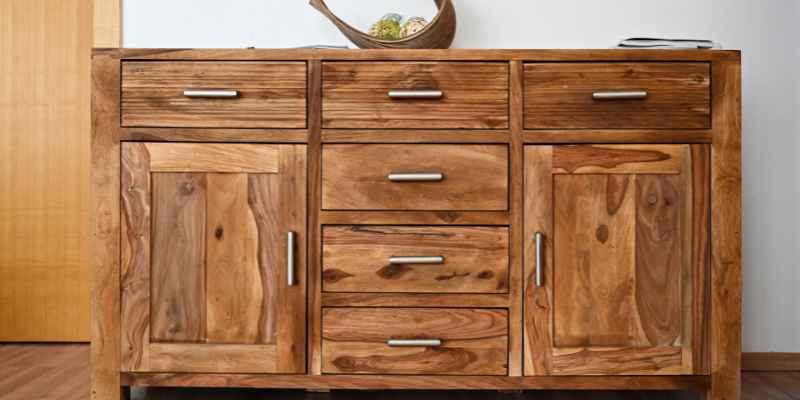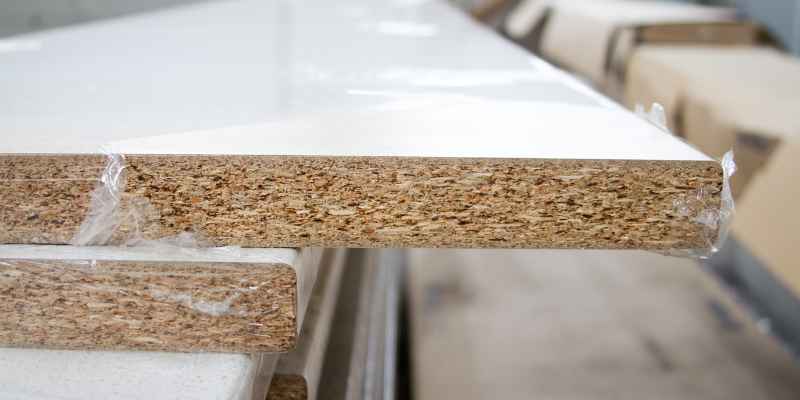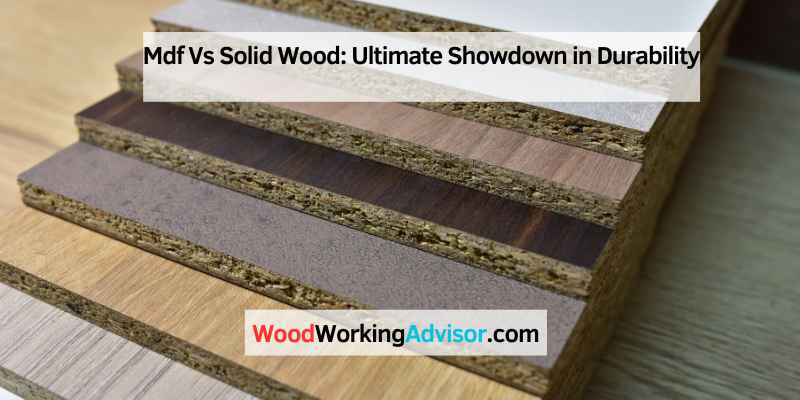MDF is an engineered wood product made from wood fibers, while solid wood is natural lumber. Both have distinct advantages and uses.
MDF (Medium Density Fiberboard) and solid wood are popular choices in furniture and cabinetry. MDF is created by breaking down hardwood or softwood residuals into wood fibers, combining them with wax and resin, and forming panels through high temperature and pressure.
It offers a smooth surface ideal for painting and is more affordable than solid wood. Solid wood, derived directly from trees, boasts unmatched natural beauty and durability. It’s excellent for high-end furniture but can be more expensive and susceptible to warping. Choosing between MDF and solid wood depends on your project’s budget, aesthetic preferences, and functional requirements.
Material Showdown: Mdf Vs Solid Wood
MDF stands for Medium-Density Fiberboard. It is made from wood fibers combined with resin. MDF is smooth and has no knots or grain. This makes it easy to paint. It is also cheaper than solid wood. MDF is heavy but not as strong. It can easily break under pressure. MDF is often used for furniture and cabinets.
Solid wood is 100% natural wood. It is cut from trees and has a natural grain. Solid wood is very strong and durable. It can last for many years. It can be sanded and refinished multiple times. Solid wood is more expensive than MDF. It can have knots and imperfections. This adds character but can make it harder to work with. Solid wood is often used for high-quality furniture.

Composition And Manufacturing
MDF stands for Medium Density Fiberboard. It is made from wood fibers mixed with resin and wax. These materials are compressed together under high pressure. This process creates a dense and smooth board. MDF is uniform in texture, making it easy to cut and shape. It is often used in furniture and cabinetry.
Solid wood comes from trees. It is cut into planks and boards. Each piece has a unique grain pattern. Solid wood is strong and durable. It can last for many years. It is often used in high-quality furniture and flooring.
Aesthetic Appeal And Design Flexibility
MDF offers a smooth and consistent finish. It is easy to paint and looks elegant. No grain patterns mean no imperfections. This makes MDF perfect for modern, sleek designs. Custom shapes and designs are easy with MDF. It is also cheaper than solid wood.
Solid wood has unique and beautiful grain patterns. Each piece is different and adds character. Natural wood grain enhances the beauty of furniture. It is perfect for classic and rustic designs. Solid wood is also very durable and long-lasting. Natural variations give a rich and warm feel.
Durability And Longevity
MDF stands for Medium-Density Fiberboard. It is made from wood fibers. These fibers are glued together. MDF is less durable than solid wood. It can swell if it gets wet. It does not handle heavy loads well. MDF is good for indoor use. It is cheaper than solid wood. MDF needs care to last long.
Solid wood is very strong. It can last for many years. Solid wood comes from trees. It is natural and beautiful. Solid wood can handle heavy loads. It is good for furniture. Solid wood can be repaired easily. It is more expensive than MDF. Solid wood can be used outdoors. It resists water better than MDF.
Resistance To Environmental Factors
MDF resists warping and cracking better than solid wood. Solid wood, though durable, can be more susceptible to moisture and temperature changes. MDF’s consistent composition provides more stability in varying environmental conditions.
Mdf And Humidity
MDF can absorb moisture easily. This can make it swell and warp. It is not a good choice for humid areas. Bathrooms and kitchens are places where MDF should be avoided. Sealing MDF can help, but only to a certain extent. Painting MDF can offer some protection from moisture. Still, it remains less durable than solid wood in humid conditions.
Solid Wood In Various Climates
Solid wood handles humidity better. It can expand and contract with changes in moisture. This makes it more suitable for various climates. High humidity can still cause some warping in solid wood. Proper sealing and finishing can protect it well. Solid wood furniture lasts longer in diverse environmental conditions.
Maintenance And Care Requirements
MDF needs gentle cleaning. Use a soft cloth to remove dust. Avoid using water on MDF. It can swell and get damaged. Use a mild cleaner for sticky spots. Keep it dry and avoid moisture. Use coasters for drinks. Protect from heat and sunlight.
Solid wood requires more care. Dust with a soft cloth. Use wood polish occasionally. Wipe spills immediately. Water can damage wood. Use coasters and placemats. Avoid direct sunlight. Heat can warp the wood. Keep humidity levels steady.
Cost Comparison
MDF is a cheaper option. It costs less than solid wood. MDF is made from wood fibers. These fibers are glued together. This makes it less expensive. MDF is good for budget projects. It is often used in furniture. MDF does not last as long as solid wood. But it is good for short-term use.
Solid wood is more expensive. It costs more than MDF. Solid wood is made from natural trees. This makes it very strong. Solid wood lasts a very long time. It is a good investment. Solid wood is often used in high-quality furniture. It looks very beautiful. Solid wood can be refinished many times. This keeps it looking new.
Environmental Impact And Sustainability
MDF, made from recycled wood fibers, often has a lower environmental impact compared to solid wood. Solid wood, though durable and natural, may contribute to deforestation if sourced unsustainably.
Mdf’s Eco-footprint
MDF uses recycled wood fibers, making it a sustainable choice. Manufacturing MDF produces fewer greenhouse gases than producing solid wood. The process uses adhesive resins, which can emit volatile organic compounds (VOCs). Choosing low-VOC MDF can reduce this impact. MDF also makes use of wood waste, which helps in reducing deforestation.
Sourcing Solid Wood Responsibly
Solid wood is a natural and durable material. Sourcing wood responsibly helps in maintaining forest health. Certified wood ensures that trees are replanted and managed sustainably. Forest Stewardship Council (FSC) certification is a good indicator of responsible sourcing. Buying local wood reduces carbon footprint due to lower transportation needs.
Application Scenarios And Best Uses
MDF is great for indoor projects. It is often used for furniture like shelves and cabinets. It is also used for paneling and moldings. MDF is smooth and easy to paint. It does not have a grain, which makes it perfect for veneers. MDF is also cheaper than solid wood. It is a good choice for budget-friendly projects.
Solid wood is best for high-quality furniture. It is very durable and long-lasting. Solid wood is great for tables, chairs, and cabinets. It has a natural grain that looks beautiful. Solid wood can be sanded and refinished many times. It is perfect for heirloom pieces and antiques. Solid wood is more expensive but worth the cost for premium projects.
The Verdict: Making The Right Choice For Your Needs
MDF is less expensive and can be a great choice for many projects. It is smooth, making it easy to paint. MDF does not warp easily, which is a big plus. Solid wood is more durable and has a natural look. It can be sanded and refinished multiple times. Solid wood is stronger and can hold more weight.
MDF is best for indoor projects like cabinets and shelves. It is also good for painted furniture. Solid wood is ideal for furniture that needs to last long. It is perfect for items that need to be strong. Think about your needs before choosing.

Frequently Asked Questions
What Are The Disadvantages Of Mdf?
MDF is less durable than solid wood. It can swell and warp with moisture. It emits formaldehyde. It’s heavy and hard to screw into.
Is Solid Wood Door Better Than Mdf?
Solid wood doors offer durability and a classic look. MDF doors are more affordable and resist warping. Choose based on budget and preference.
Where Should You Not Use Mdf?
Avoid using MDF in areas with high moisture or humidity, like bathrooms and kitchens. It can swell and warp. MDF is also unsuitable for heavy load-bearing structures. It may not hold screws well over time. Use it for indoor, decorative, or low-stress applications.
Conclusion
Choosing between MDF and solid wood depends on your needs and preferences. MDF is cost-effective and versatile. Solid wood offers durability and a classic look. Both materials have their advantages and drawbacks. Consider your budget and design goals. This will help you make an informed decision for your next project.


